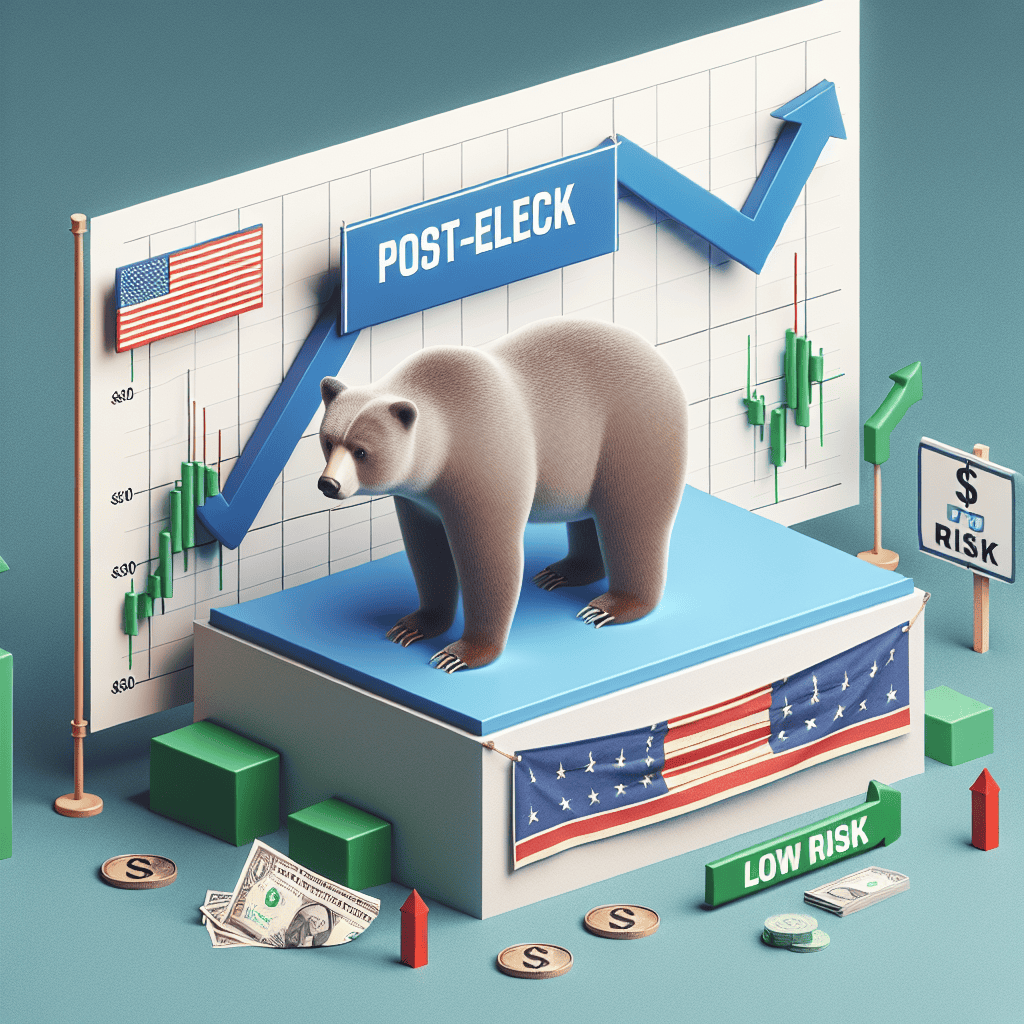“Goldman Sees Bullish Horizon: Low Bear Market Risk Fuels Economic Optimism Post-Election”
Introduction
Goldman Sachs has projected a diminished risk of a bear market following the recent election, buoyed by a wave of economic optimism. The investment banking giant’s analysis suggests that the political stability and anticipated policy continuity post-election are likely to foster a favorable environment for economic growth. This outlook is further supported by robust corporate earnings and resilient consumer spending, which together paint a promising picture for the financial markets. As investors navigate the post-election landscape, Goldman Sachs’ insights provide a reassuring perspective on the potential for sustained market stability and growth.
Economic Optimism: A Catalyst for Market Stability
In the wake of the recent election, Goldman Sachs has projected a diminished risk of a bear market, attributing this outlook to a burgeoning sense of economic optimism. This perspective is rooted in a confluence of factors that collectively suggest a stable and potentially prosperous economic environment. As investors and analysts alike scrutinize the post-election landscape, the prevailing sentiment is one of cautious optimism, bolstered by several key indicators that point towards sustained market stability.
To begin with, the election results have ushered in a period of political clarity, which is often a precursor to economic confidence. Historically, markets tend to react favorably to reduced political uncertainty, as it allows businesses and investors to make more informed decisions. This newfound clarity is expected to foster an environment conducive to investment and growth, thereby reducing the likelihood of a bear market. Moreover, the election has set the stage for potential policy shifts that could further stimulate economic activity. With a focus on infrastructure development, tax reforms, and regulatory adjustments, the anticipated policy changes are likely to enhance business conditions and spur economic expansion.
In addition to political factors, the current economic indicators paint a promising picture. Unemployment rates have been steadily declining, signaling a robust labor market that is poised to support consumer spending. Consumer confidence, a critical driver of economic growth, has also shown signs of improvement, reflecting the public’s positive outlook on their financial prospects. This optimism is expected to translate into increased consumer spending, which in turn fuels business revenues and supports market stability.
Furthermore, corporate earnings have been on an upward trajectory, with many companies reporting better-than-expected results. This trend is indicative of strong business fundamentals and suggests that companies are well-positioned to navigate potential challenges. The resilience of corporate earnings is a crucial factor in sustaining investor confidence and mitigating the risk of a bear market. Additionally, the global economic landscape is showing signs of recovery, with key international markets rebounding from previous downturns. This global resurgence is likely to have a positive spillover effect on domestic markets, further bolstering economic optimism.
Another significant factor contributing to the optimistic outlook is the accommodative monetary policy stance adopted by central banks. Low interest rates and quantitative easing measures have provided ample liquidity to the financial system, supporting asset prices and encouraging investment. This monetary environment is expected to persist in the near term, providing a stable backdrop for economic growth and reducing the likelihood of a market downturn.
While the potential for unforeseen challenges remains, the current economic landscape suggests that the risk of a bear market is relatively low. The combination of political clarity, strong economic indicators, resilient corporate earnings, and supportive monetary policy creates a favorable environment for market stability. As investors navigate the post-election period, the prevailing sentiment is one of cautious optimism, underpinned by a belief in the economy’s capacity to sustain growth and weather potential headwinds.
In conclusion, Goldman Sachs’ prediction of low bear market risk post-election is grounded in a comprehensive analysis of the current economic climate. The interplay of political, economic, and monetary factors has fostered a sense of optimism that is likely to serve as a catalyst for market stability. As the economy continues to demonstrate resilience and adaptability, the outlook remains positive, with the potential for sustained growth and prosperity in the months ahead.
Post-Election Market Trends: What to Expect
In the wake of the recent election, market analysts and investors are keenly observing the potential shifts in economic trends and their implications for the financial markets. Goldman Sachs, a leading global investment banking firm, has provided an optimistic outlook, suggesting a low risk of a bear market in the post-election period. This prediction is rooted in a combination of factors that collectively paint a picture of economic resilience and potential growth.
To begin with, the election results have ushered in a sense of political stability, which is often a crucial determinant of market confidence. Historically, markets tend to react positively to clear and decisive election outcomes, as they reduce uncertainty and provide a clearer policy direction. This political clarity is expected to foster an environment conducive to economic growth, thereby reducing the likelihood of a prolonged market downturn.
Moreover, the current economic indicators suggest a robust recovery trajectory, further supporting Goldman Sachs’ optimistic forecast. Key metrics such as employment rates, consumer spending, and industrial production have shown significant improvement, signaling a strong rebound from previous economic disruptions. This recovery is bolstered by ongoing fiscal and monetary policies aimed at sustaining growth and mitigating potential economic shocks. For instance, continued government stimulus measures and accommodative monetary policies by central banks have provided a solid foundation for economic expansion.
In addition to domestic factors, global economic conditions also play a pivotal role in shaping market trends. The international economic landscape is showing signs of stabilization, with major economies gradually recovering from the impacts of recent global challenges. This global recovery is expected to enhance trade and investment opportunities, further contributing to a positive market outlook. As international markets stabilize, they provide a supportive backdrop for domestic economic growth, thereby reducing the risk of a bear market.
Furthermore, corporate earnings have been on an upward trajectory, reflecting the resilience and adaptability of businesses in navigating the current economic environment. Many companies have successfully implemented strategies to enhance operational efficiency and capitalize on emerging market opportunities. This has resulted in stronger-than-expected earnings reports, which have, in turn, bolstered investor confidence and contributed to a more favorable market sentiment.
While the overall outlook remains positive, it is important to acknowledge potential risks that could impact market trends. Geopolitical tensions, unexpected policy shifts, and unforeseen economic disruptions could pose challenges to the optimistic forecast. However, the current economic fundamentals and policy measures in place provide a strong buffer against these potential risks.
In conclusion, Goldman Sachs’ prediction of a low bear market risk post-election is underpinned by a confluence of factors that suggest a favorable economic environment. Political stability, robust economic indicators, global recovery, and strong corporate earnings collectively contribute to this optimistic outlook. While potential risks remain, the prevailing economic conditions and policy frameworks provide a solid foundation for sustained market growth. As investors navigate the post-election landscape, these insights offer valuable guidance on what to expect in the coming months.
Goldman Sachs’ Analysis: Understanding Bear Market Risks
Goldman Sachs, a leading global investment banking, securities, and investment management firm, has recently provided an optimistic outlook on the potential risks of a bear market following the upcoming election. This analysis comes at a time when investors are keenly observing economic indicators and market trends to gauge the future trajectory of financial markets. The firm’s assessment is rooted in a comprehensive evaluation of current economic conditions, political stability, and market dynamics, which collectively suggest a reduced likelihood of a bear market in the near term.
To begin with, Goldman Sachs highlights the resilience of the current economic environment as a key factor mitigating bear market risks. Despite the challenges posed by recent global events, such as the pandemic and geopolitical tensions, the economy has demonstrated a remarkable capacity for recovery and growth. This resilience is evidenced by robust corporate earnings, steady consumer spending, and a strong labor market. These elements contribute to a favorable economic backdrop that supports continued market expansion and reduces the probability of a significant downturn.
Moreover, the firm’s analysis underscores the importance of political stability in shaping market sentiment. The upcoming election, while a focal point of uncertainty, is not expected to disrupt the underlying economic fundamentals significantly. Historically, markets have shown a tendency to stabilize post-election as political uncertainties are resolved and policy directions become clearer. Goldman Sachs posits that the anticipated policy continuity and potential for bipartisan cooperation on key economic issues will further bolster investor confidence, thereby diminishing the risk of a bear market.
In addition to economic and political factors, Goldman Sachs also considers the role of monetary policy in its assessment. The current accommodative stance of central banks, characterized by low interest rates and supportive monetary measures, provides a conducive environment for economic growth and market stability. This policy approach is likely to persist in the near term, offering a buffer against potential market volatility and enhancing the prospects for sustained market gains.
Furthermore, the firm’s analysis takes into account the global economic landscape, which is showing signs of recovery and expansion. As major economies continue to rebound from the disruptions caused by the pandemic, there is a growing sense of optimism about future growth prospects. This global recovery is expected to have positive spillover effects on financial markets, further reducing the likelihood of a bear market scenario.
While acknowledging the presence of certain risks, such as inflationary pressures and potential geopolitical tensions, Goldman Sachs remains confident in its assessment of low bear market risk. The firm’s analysis suggests that these risks are manageable and unlikely to derail the overall positive economic trajectory. By maintaining a vigilant approach to monitoring these factors, investors can navigate potential challenges while capitalizing on opportunities for growth.
In conclusion, Goldman Sachs’ analysis presents a compelling case for optimism regarding bear market risks in the post-election period. By examining a range of economic, political, and monetary factors, the firm provides a nuanced perspective that emphasizes the resilience and stability of the current market environment. As investors continue to assess the evolving landscape, this analysis serves as a valuable guide for understanding the potential risks and opportunities that lie ahead.
The Role of Economic Indicators in Market Predictions

In the realm of financial markets, the interplay between economic indicators and market predictions is a subject of perennial interest. Recently, Goldman Sachs has projected a low risk of a bear market following the upcoming election, buoyed by a wave of economic optimism. This forecast underscores the critical role that economic indicators play in shaping market expectations and investor sentiment. To understand this dynamic, it is essential to delve into the specific indicators that inform such predictions and how they interact with broader economic trends.
Economic indicators, such as GDP growth rates, employment figures, inflation levels, and consumer confidence indices, serve as vital tools for analysts and investors alike. These metrics provide a snapshot of the economy’s current health and offer insights into future performance. For instance, robust GDP growth often signals a thriving economy, which can lead to increased corporate earnings and, consequently, higher stock prices. Similarly, low unemployment rates typically indicate strong consumer spending power, further fueling economic expansion.
In the context of Goldman’s prediction, several key indicators have contributed to the optimistic outlook. First, the labor market has shown remarkable resilience, with unemployment rates remaining low and job creation continuing at a steady pace. This strength in employment not only supports consumer spending but also bolsters overall economic confidence. Additionally, inflation, while a concern in recent years, has shown signs of stabilizing, alleviating fears of runaway price increases that could dampen economic growth.
Moreover, consumer confidence has remained relatively high, suggesting that individuals are optimistic about their financial prospects and the broader economy. This sentiment is crucial, as consumer spending accounts for a significant portion of economic activity. When consumers feel confident, they are more likely to make purchases, invest in property, and contribute to economic momentum. Consequently, this positive consumer outlook has been a key factor in Goldman’s assessment of reduced bear market risk.
Transitioning to the corporate sector, earnings reports have generally exceeded expectations, further reinforcing the positive economic narrative. Companies across various industries have demonstrated resilience and adaptability, navigating challenges such as supply chain disruptions and geopolitical tensions. This corporate strength not only supports stock market valuations but also instills confidence in investors regarding the sustainability of economic growth.
Furthermore, monetary policy has played a pivotal role in shaping market predictions. Central banks, including the Federal Reserve, have signaled a commitment to maintaining accommodative policies to support economic recovery. Low interest rates and quantitative easing measures have provided liquidity to financial markets, encouraging investment and lending. This supportive monetary environment has been instrumental in fostering economic optimism and reducing the perceived risk of a bear market.
In conclusion, the interplay between economic indicators and market predictions is a complex yet fascinating process. Goldman’s forecast of low bear market risk post-election is underpinned by a confluence of positive economic indicators, including strong labor markets, stable inflation, high consumer confidence, robust corporate earnings, and supportive monetary policy. These factors collectively paint a picture of an economy poised for continued growth, thereby reducing the likelihood of a significant market downturn. As investors navigate the post-election landscape, these indicators will remain crucial in shaping their strategies and expectations.
Investor Confidence: How Elections Influence Market Sentiment
In the wake of the recent election, investor confidence appears to be on an upswing, bolstered by Goldman Sachs’ optimistic forecast regarding the bear market risk. Historically, elections have played a pivotal role in shaping market sentiment, often leading to periods of volatility as investors grapple with the potential policy shifts that accompany new administrations. However, the current post-election landscape presents a unique scenario where economic optimism seems to outweigh the usual apprehensions associated with political transitions.
Goldman Sachs, a leading global investment banking firm, has projected a low risk of a bear market in the near future, attributing this outlook to several key economic indicators that suggest a robust economic trajectory. This prediction comes at a time when markets are typically sensitive to the uncertainties of a new government, yet the prevailing sentiment is one of cautious optimism. The firm’s analysis points to strong corporate earnings, resilient consumer spending, and a steady recovery in the labor market as fundamental drivers of this positive outlook.
Moreover, the election results have provided a sense of stability, with investors interpreting the outcome as conducive to continued economic growth. The anticipated policy measures, which are expected to focus on infrastructure development, technological innovation, and sustainable energy, have further fueled this optimism. These initiatives are likely to stimulate economic activity, create jobs, and enhance productivity, thereby reinforcing the market’s upward momentum.
Transitioning from the political to the economic realm, it is essential to consider how the interplay between fiscal policies and market dynamics can influence investor behavior. The current administration’s commitment to maintaining a balanced approach to fiscal stimulus and monetary policy has been well-received by the financial community. This approach is expected to mitigate inflationary pressures while supporting economic expansion, thus reducing the likelihood of a bear market scenario.
Furthermore, the global economic environment plays a crucial role in shaping domestic market sentiment. As international trade relations stabilize and geopolitical tensions ease, there is a renewed sense of confidence among investors. This global perspective is vital, as it underscores the interconnectedness of markets and the importance of a stable international economic framework in fostering investor confidence.
In addition to these macroeconomic factors, technological advancements and innovation continue to drive market optimism. The rapid pace of digital transformation across various sectors has opened new avenues for growth and investment, providing a buffer against potential market downturns. Companies that are at the forefront of this technological revolution are likely to attract significant investor interest, further bolstering market sentiment.
In conclusion, while elections traditionally introduce an element of uncertainty into the financial markets, the current post-election period is characterized by a sense of economic optimism that is reflected in Goldman’s low bear market risk prediction. This outlook is supported by strong economic fundamentals, favorable policy expectations, and a stable global environment. As investors navigate this landscape, the interplay between political developments and economic indicators will continue to shape market sentiment, underscoring the importance of a nuanced understanding of these dynamics in making informed investment decisions.
Strategies for Navigating Markets in a Low-Risk Environment
In the wake of the recent election, Goldman Sachs has projected a low risk of a bear market, buoyed by a wave of economic optimism. This forecast presents a unique opportunity for investors to recalibrate their strategies in a market environment characterized by reduced volatility and increased stability. As the political landscape stabilizes, the focus shifts to the economic indicators that suggest a robust recovery, providing fertile ground for strategic investment decisions.
To begin with, the post-election period often brings a sense of predictability, as policy directions become clearer and market participants adjust their expectations accordingly. This newfound clarity can lead to increased investor confidence, which in turn reduces the likelihood of abrupt market downturns. Goldman Sachs’ analysis underscores this sentiment, highlighting key economic indicators such as GDP growth, employment rates, and consumer spending, all of which point towards a sustained economic recovery. Consequently, investors are encouraged to consider strategies that capitalize on this positive momentum.
One approach to navigating this low-risk environment is to focus on sectors that are poised for growth in the current economic climate. For instance, technology and healthcare have consistently demonstrated resilience and innovation, making them attractive options for investors seeking long-term gains. Additionally, the infrastructure sector is expected to benefit from potential government spending initiatives aimed at revitalizing the economy. By strategically allocating resources to these promising sectors, investors can position themselves to reap the benefits of a thriving market.
Moreover, diversification remains a cornerstone of any sound investment strategy, particularly in a low-risk environment. By spreading investments across a variety of asset classes, investors can mitigate potential risks while maximizing returns. This approach not only provides a buffer against unforeseen market fluctuations but also allows investors to take advantage of different growth opportunities. In light of Goldman Sachs’ optimistic outlook, diversification can serve as a prudent strategy to ensure a balanced and resilient portfolio.
Furthermore, the current economic optimism presents an opportune moment for investors to reassess their risk tolerance and investment goals. With the reduced likelihood of a bear market, there is room for more aggressive strategies that may have been deemed too risky in a more volatile environment. Investors might consider increasing their exposure to equities, which historically offer higher returns compared to other asset classes. However, it is essential to maintain a disciplined approach, ensuring that any adjustments align with long-term financial objectives.
In addition to these strategies, staying informed about ongoing economic developments and policy changes is crucial. The post-election landscape is dynamic, and being attuned to shifts in fiscal and monetary policies can provide valuable insights for making informed investment decisions. Regularly reviewing and adjusting investment strategies in response to new information can help investors stay ahead of the curve and capitalize on emerging opportunities.
In conclusion, Goldman Sachs’ prediction of a low bear market risk post-election, coupled with economic optimism, offers a promising outlook for investors. By focusing on growth sectors, embracing diversification, reassessing risk tolerance, and staying informed, investors can effectively navigate this low-risk environment. As the economy continues to recover and stabilize, these strategies can serve as a foundation for achieving sustainable financial success in the years to come.
The Impact of Political Stability on Economic Growth
In the wake of the recent election, Goldman Sachs has projected a diminished risk of a bear market, attributing this outlook to a renewed sense of economic optimism. This prediction underscores the intricate relationship between political stability and economic growth, a dynamic that has long been observed by economists and market analysts alike. Political stability often serves as a bedrock for economic confidence, as it provides a predictable environment in which businesses can plan and invest. In this context, the recent election results have seemingly alleviated some of the uncertainties that typically accompany political transitions, thereby fostering a more favorable economic climate.
The connection between political stability and economic performance is multifaceted. On one hand, stable political environments tend to encourage investment by reducing the risks associated with sudden policy shifts or regulatory changes. Investors, both domestic and international, are more likely to commit capital when they perceive a low likelihood of disruptive political events. On the other hand, political stability can also enhance consumer confidence, as individuals feel more secure in their economic prospects and are thus more willing to spend. This increase in consumer spending can, in turn, stimulate economic growth, creating a virtuous cycle of prosperity.
Moreover, the recent election has brought about a sense of continuity in economic policy, which is crucial for maintaining investor confidence. When businesses and investors can anticipate the trajectory of fiscal and monetary policies, they are better equipped to make long-term decisions. This predictability is particularly important in sectors that require significant capital investment, such as infrastructure, technology, and manufacturing. By reducing the element of surprise, political stability allows these sectors to thrive, contributing to overall economic growth.
In addition to fostering investment and consumer confidence, political stability can also enhance a country’s ability to engage in international trade. Stable governments are often seen as reliable partners in trade agreements, which can lead to increased exports and imports. This, in turn, can boost economic growth by opening up new markets for domestic producers and providing consumers with access to a wider array of goods and services. Furthermore, stable political environments are less likely to impose sudden trade barriers or tariffs, which can disrupt global supply chains and hinder economic progress.
While the recent election has contributed to a more stable political landscape, it is important to recognize that other factors also play a role in shaping economic outcomes. For instance, global economic conditions, technological advancements, and demographic trends can all influence a country’s economic trajectory. Nevertheless, political stability remains a critical component of economic growth, as it provides the foundation upon which other factors can build.
In conclusion, Goldman Sachs’ prediction of a low bear market risk post-election highlights the positive impact of political stability on economic growth. By reducing uncertainty and fostering a predictable environment, political stability encourages investment, boosts consumer confidence, and facilitates international trade. As such, it is a key driver of economic prosperity, underscoring the importance of stable governance in achieving sustainable growth. As the world continues to navigate complex economic challenges, the role of political stability in shaping economic outcomes will remain a topic of significant interest and importance.
Q&A
1. **What is Goldman Sachs’ prediction regarding the bear market risk post-election?**
Goldman Sachs predicts a low risk of a bear market following the election.
2. **What is the primary reason for Goldman Sachs’ optimistic outlook?**
The primary reason for the optimistic outlook is economic optimism.
3. **How does Goldman Sachs view the current economic conditions?**
Goldman Sachs views the current economic conditions as favorable, contributing to their positive market outlook.
4. **What factors contribute to Goldman Sachs’ economic optimism?**
Factors contributing to economic optimism include strong economic indicators, potential policy stability post-election, and robust corporate earnings.
5. **Does Goldman Sachs expect any significant market volatility post-election?**
While some volatility is expected, Goldman Sachs does not anticipate significant or prolonged market disruptions.
6. **How might the election results impact Goldman Sachs’ market predictions?**
The election results could influence market dynamics, but Goldman Sachs believes the overall economic fundamentals will mitigate major risks.
7. **What sectors does Goldman Sachs believe will perform well post-election?**
Goldman Sachs expects sectors tied to economic growth, such as technology and consumer discretionary, to perform well post-election.
Conclusion
Goldman Sachs’ analysis suggests a reduced risk of a bear market following the election, driven by a positive economic outlook. The firm’s optimism is based on anticipated policy stability and potential fiscal stimulus, which are expected to bolster economic growth. Additionally, strong corporate earnings and resilient consumer spending contribute to this favorable forecast. However, while the immediate risk of a bear market appears low, investors should remain vigilant to potential geopolitical tensions and unexpected economic shifts that could alter this outlook. Overall, Goldman’s prediction reflects confidence in the market’s ability to navigate post-election dynamics effectively.





